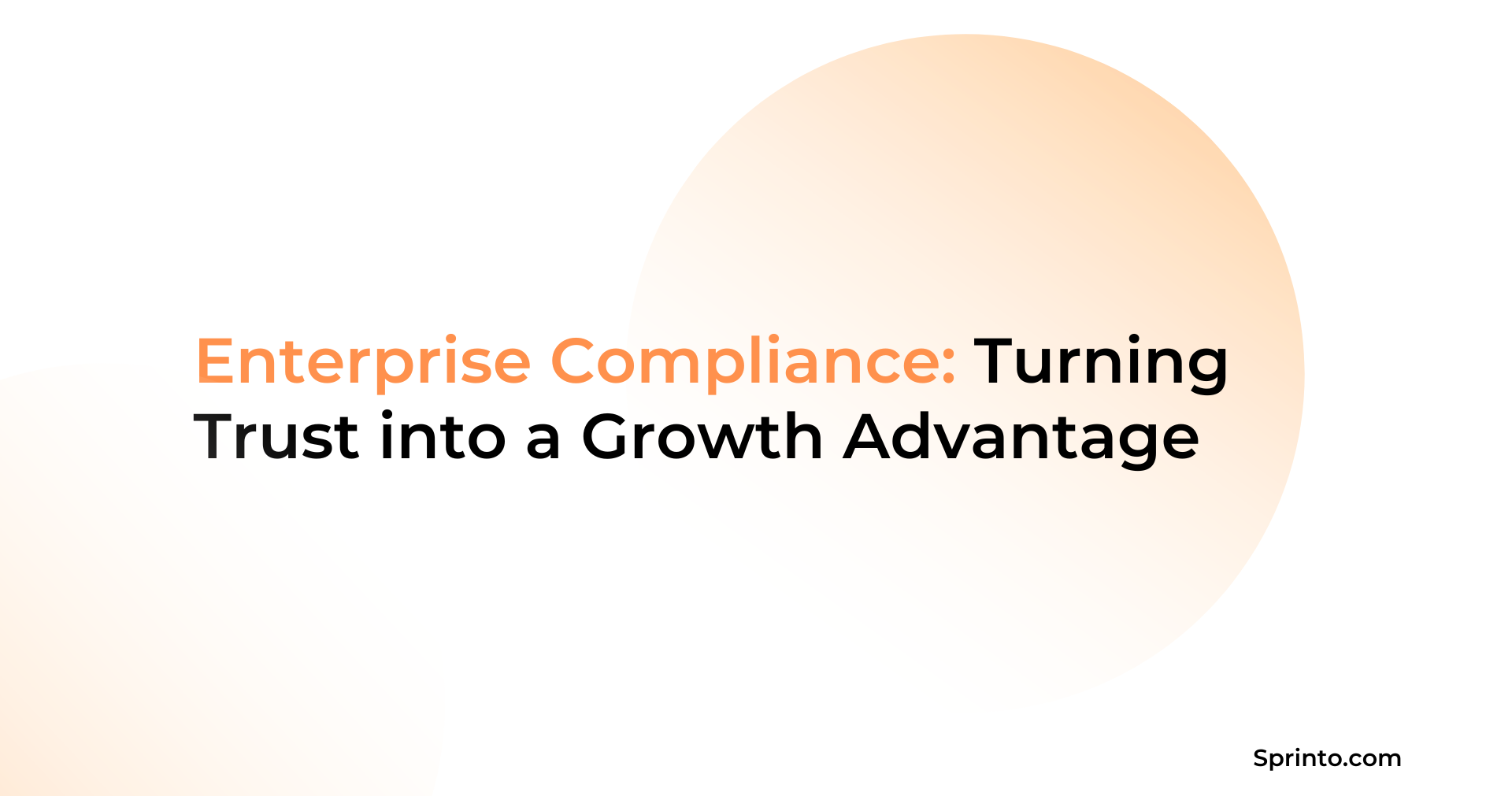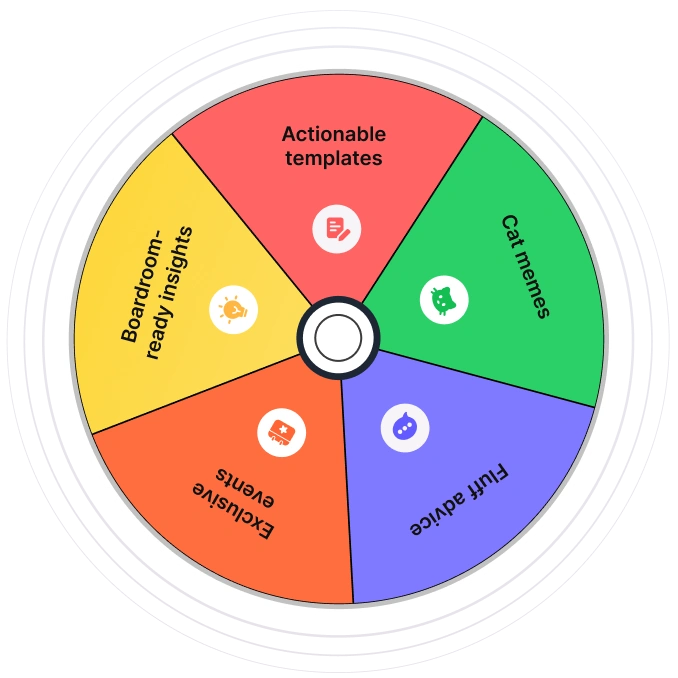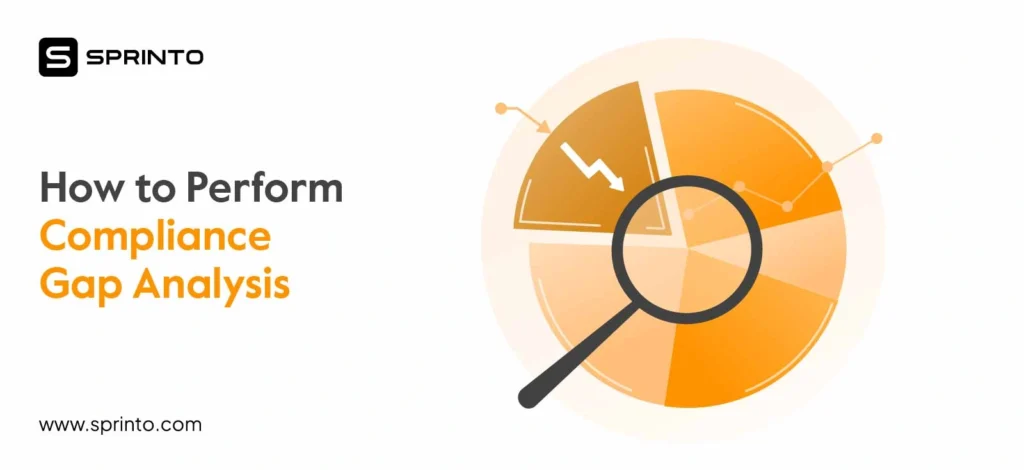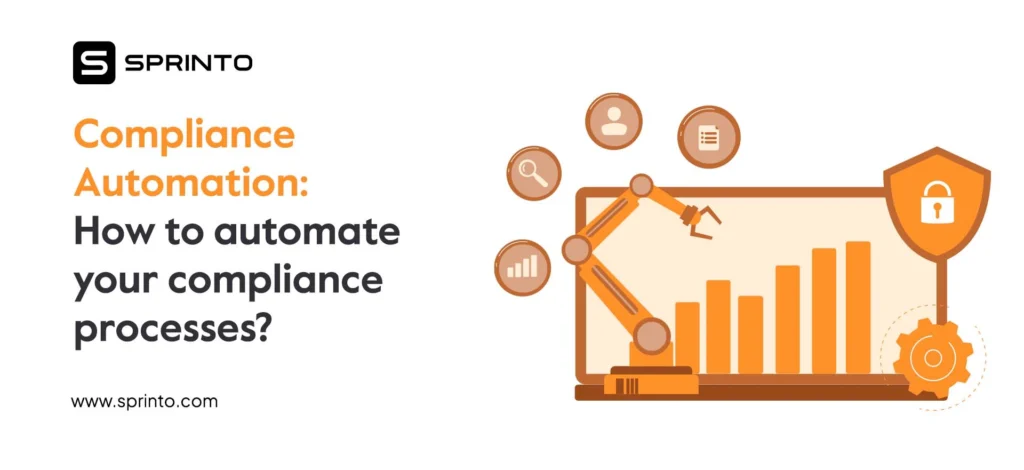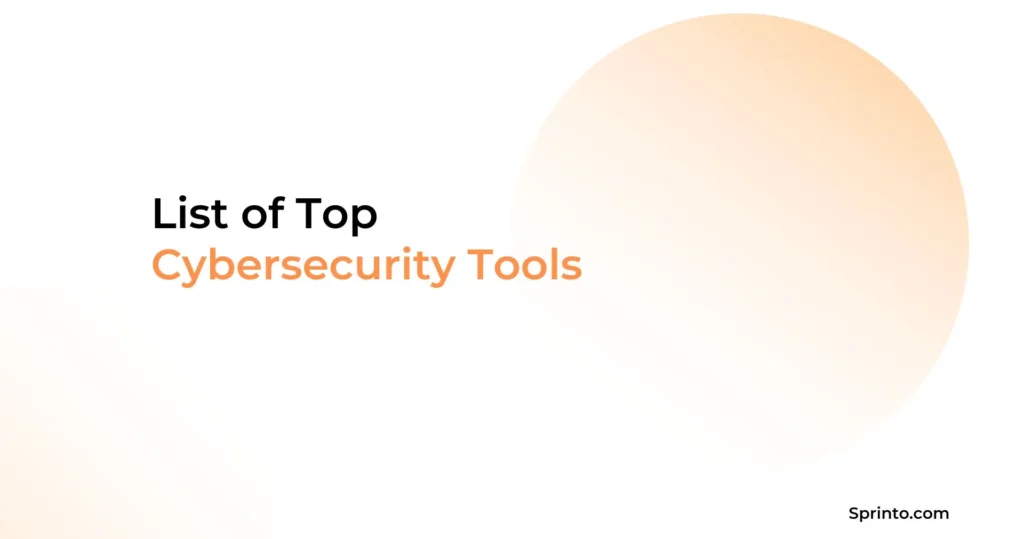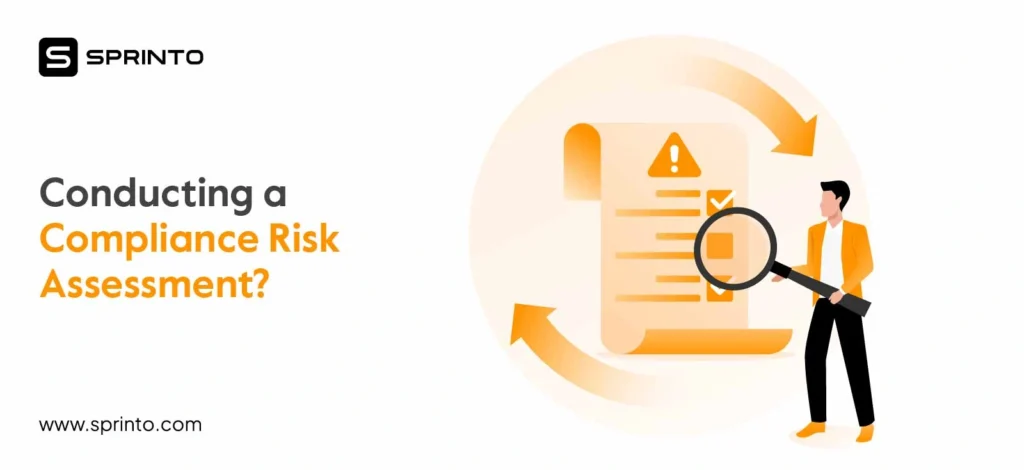Enterprises today compete on trust as much as they do on product features and price. That trust is built on showing how well a company handles compliance, right from safeguarding customer data to proving ESG commitments.
Done right, enterprise compliance signals credibility, resilience and scalability. Yet when managed in silos across legal, security and other functions, it slows decisions, lengthens sales cycles, and weakens trust and credibility.
In this blog, we will explore what enterprise compliance means in today’s trust-led markets.
TL;DR
- Enterprise compliance manages multiple standards, frameworks, and regulations under one unified program.
- It helps enterprises maintain trust, reduce risks, and streamline operations across geographies and business units.
- Challenges may arise from fast-changing rules, limited team capacity, and data sprawl.
- Compliance automation closes these gaps and brings visibility, consistency, and resilience across the enterprise.
What is enterprise compliance?
Enterprise compliance is the system that helps you prove that your business can be trusted to operate responsibly. Built from top down, enterprise compliance builds a unified compliance framework that keeps people, processes, and technology aligned. With multiple business units and departments operating across different geographies, enterprise compliance plays the connective tissue that binds everything together.
Compliance gets more complex as you scale with multiple requirements, across multiple compliance frameworks and jurisdictions. Enterprise compliance turns a complex set of requirements into a coherent framework that leadership can rely on and stakeholders can trust. It ensures that legal, finance, security, HR, and operations have a shared picture of trust and readiness.
Why enterprises can’t afford to ignore compliance?
At the enterprise level, compliance goes beyond avoiding penalties or passing audits. It’s about proving that your business can be trusted at scale. In an environment where the stakes are higher, every market entry becomes more scrutinized, and every deal is bigger, compliance becomes THE foundation of credibility.
In practice, compliance plays a vital role in the following ways:
- Accelerated sales cycles: Buyers are more cautious when assessing and negotiating big-ticket purchases. They want proof you’re safe to work with before they sign. Having recognized certifications and audit-ready evidence upfront is what helps close deals faster.
- Protects brand reputation: Even a single lapse, like weak vendor control, can wipe out years of trust. Continuously capturing evidence as part of your daily operations demonstrates that you can scale without disruptions.
- Keeps expansion on track: Entering a new market or launching in a new vertical comes with a compliance test. A strong compliance posture ensures your security, labor, and data practices align with local laws so that legal or regulatory roadblocks never inhibit growth.
- Signals value, not just absence of risk: Research by Haugh & Bedi shows that customers are willing to pay a premium price to companies with robust, transparent compliance. So compliance becomes a pricing and positioning lever, not just a cost.
- Strengthens decision-making: A strong commitment to compliance means your leadership gets a real-time view of your risk and readiness. This confidence is critical when making strategic bets on product launches and global partnerships.
Common compliance standards for large organizations
Compliance isn’t one-size-fits-all, especially for enterprise-scale companies operating across multiple regulations, laws, and jurisdictions. Some of the most common enterprise compliance standards include:
1. GDPR & CCPA
Privacy regulations such as GDPR in Europe and CCPA in California lay out strict requirements for handling personal information. These compliance frameworks set the bar for how personal data is collected, stored, and processed.
2. SOC2
SOC2 is an important security compliance framework for SaaS and technology companies that work with enterprise clients. It demonstrates your commitment to implementing and testing controls regarding security, confidentiality, availability, process integrity, and privacy.
3. ISO 27001
The international benchmark for information security, ISO 27001, signals that your practices are audited and mature.
4. HIPAA
The Health Insurance Portability and Accountability Act (HIPAA) is critical to any organization dealing with protected health information. It dictates how healthcare data must be safeguarded and handled responsibly.
5. PCI DSS
This compliance framework is ideal for any business processing credit card payments. It ensures that customer payment data is secure and transactions remain uninterrupted.
6. NIS2
NIS2 is focused on broadening the scope of cybersecurity obligations. It introduces strict requirements for governance, third-party risk management, and incident reporting.
Enterprise compliance program framework
Brief for image: A 4-pillar illustration where each pillar is labeled to represent one of the foundational elements of enterprise compliance:
- Governance & Oversight (icon of a leadership figure or boardroom table)
- Risk Management (icon of a shield with an exclamation mark or risk chart)
- Policies & Controls (icon of a document with a checklist or rules)
- Monitoring & Continuous Improvement (icon of a magnifying glass over data)
Most enterprise compliance frameworks share the same DNA: structured, repeatable, and scalable. The frameworks may use different languages, but the building blocks are nearly identical.
For enterprises, a compliance program framework essentially incorporates 4 foundational pillars:
1. Governance and oversight
Compliance shouldn’t be siloed but embedded into executive decision-making and operational priorities. This is why it’s important to establish a compliance governance structure with defined leadership, reporting, and accountability.
2. Enterprise risk management
Enterprise risk management helps systematically identifying, assessing, and prioritizing compliance-related risks across business units, geographies, and vendors. Organizations need to focus their resources where the exposure is highest and align risk control with business impact.
3. Policies and controls
Translating legal, regulatory, and internal requirements into actionable policies, standard operating procedures, and internal controls. These can serve as playbooks for employees and teams to stay compliant.
4. Monitoring and continuous improvement
Implementing continuous tracking, audits, and performance reviews to detect gaps early, validate controls, and adapt programs to new regulations or operational changes. This ensures your compliance program matures alongside the business.
While these pillars form the foundation, the actual execution comes from applying a clear set of steps.
Steps to achieve enterprise compliance
Enterprise compliance is built in layers, each reinforcing the next until compliance becomes part of how the business operates. Think of it as moving through the following stages:
1. Establish the foundation
Compliance cannot be left to a single department. At an enterprise level, clear ownership and executive sponsorship are important. Ideally, company leadership should define the compliance charter that spells out responsibility, accountability, and reporting structures across the business. This charter should set the foundation for a governance structure that keeps everyone aligned with a single truth source.
2. Assess your regulatory landscape
Compliance obligations tend to get multidimensional as you expand across geographies, markets, and industries. GDPR and CCPA may govern customer data, HIPAA may apply to health records, and SOC2 and ISO 27001 may cover security.
These frameworks tend to overlap, which is where things can get complex and overwhelming. It’s important to understand the specific requirements for each compliance framework and document them accordingly.
A good enterprise compliance management platform can do the heavy lifting for you, allowing you to take a more proactive approach to compliance than a reactive one.
3. Identify current gaps
Run internal audits and readiness assessments to measure your current state against these obligations. Unowned controls, incomplete documentation, or outdated policies can result in gaps that make your systems, data, and processes prone to risks.
It’s difficult to remediate everything at once. Focus on high-risk and high-impact areas that could amount to regulatory penalties or operational bottlenecks. For instance, healthcare organizations must treat HIPAA-related gaps in patient privacy data as top priority. This ensures that your resources are directed exactly where they matter the most.
4. Translate requirements into policies and controls
Regulations are written in broad, legal jargon. Your role is to translate them into actionable policies and enforceable controls in a way that works best for your organization.
This could take the shape of access restrictions, incident response playbooks, or vendor onboarding processes. The key challenge is implementing a baseline of universal controls while accommodating local laws, cultural nuances, and operational differences.
5. Building a culture of compliance
Policies on paper do only half the job. It’s the right behaviors and practices that help prevent risks from turning into incidents. For an enterprise with thousands of employees, compliance adoption is a huge make or break factor.
This typically requires role-specific training, such as PHI safeguards for medical staff and training employees for preventing data breaches and phishing attempts. Leadership has an important role to play here by modeling compliance visibly. Over time, compliance becomes a part of simply how you do business.
6. Monitor continuously and audit regularly
Regulations evolve, systems change, and controls drift over time. This is where continuous control monitoring (CCM) and internal audits become critical. CCM ensures that critical controls are tracked in real time, so any drift or misconfiguration is flagged before it becomes a risk.
Alongside CCM, regular internal audits help validate that monitoring is effective and aligned with evolving regulations. Together, they serve as a dual security net, one catching issues in real time while the other validating the overall program health.
7. Leverage technology for scale
Manual tracking and spreadsheet-based audits collapse under the complexity of enterprise compliance. GRC platforms and compliance automation tools centralize compliance frameworks, automate evidence collection, and provide dashboards for executive visibility.
By embedding compliance technology into daily workflows, enterprises make compliance less of a bottleneck and more of an enabler of growth.
8. Commit to continuous improvement
Compliance is not a one-and-done, static process. A merger, new regulation, or expansion into a new geography can reshape obligations overnight. Enterprises that succeed treat compliance as a living program where policies are reviewed regularly, risks are assessed, and controls are updated proactively.
This approach helps ensure your compliance strategy is proactive and always-on.
Enterprise compliance challenges
Achieving enterprise-grade compliance is never a check-boxing exercise. Organizations tend to encounter a range of challenges in handling enterprise compliance:
1. Evolving rules across borders
Multinational companies need to juggle multiple jurisdictions, each with its own frameworks. And most of the time, these regulations are not even static. So the challenge is not just to stay up to date, but also to ensure consistency across global operations without duplicating efforts.
2. Resource stretch
Compliance ends up getting compromised in front of growth goals. Reality is that even in larger enterprises, compliance teams often compete with revenue-driving departments for budgets. The result? Understaffed teams trying to manage bandwidths and difficult requirements often leading to reactive approaches.
3. Technological gaps and integration hurdles
Legacy systems don’t always integrate with modern compliance platforms. And if you’re still relying on siloed platforms, manual evidence collection or spreadsheets, you are slowing down your compliance efforts. In this way, enterprises risk fragmented control and a high-risk environment.
4. Data management and accuracy
Enterprises generate massive amounts of operational and customer data. To ensure that this data is accurate, secure, and auditable, that too at scale, can be daunting. Errors in evidence collection, misclassified data, or unauthorized access can derail compliance efforts and create vulnerabilities that regulators notice quickly.
Best practices for enterprise compliance
Enterprise compliance works best when it’s practical. Getting it right means following clear, repeatable practices that enterprises comply with today and tomorrow. Here are some practices that will help you get ahead:
1. Policy management for a strong governance framework
Policies are the backbone of compliance. Centralize policies in a system that enables version control, timely updates, and easy employee access. This ensures your policies are both living and actionable.
2. Build risk into your compliance frameworks
Compliance without the context of your risk is fragile. Run continuous risk assessment and incorporate monitoring and mitigation into compliance routines. Risks will surface before they can escalate.
3. Invest in employee training and awareness
Ongoing, role-specific training builds awareness and helps prevent unintentional violations. You can reinforce these using ongoing nudges, tools, and accessible reporting channels.
4. Building a culture of compliance
Compliance works best when embedded into the very DNA of your organization. Ethical conduct and regulatory adherence become shared values and not just obligations. It starts with recognizing compliant behavior to encourage positive reinforcement. However, it also involves making compliance guidance accessible and not buried in documents.
5. Regulator engagement
A reactive approach to regulators can leave organizations on the defensive. Proactive, transparent engagement is important for building trust and preventing escalation. Build transparent, proactive relationships with regulators. Be consistent in communication to strengthen trust with regulators.
6. Use technology as a force multiplier
Manual oversight can’t keep pace with modern risks. Automated monitoring, real-time reports, and CCM reduce human error and improve visibility.
How Sprinto Automates Compliance for Enterprise Clients
Enterprises deal with sprawling systems, distributed teams, and constant audits. Manual methods fail to keep up. Sprinto replaces manual, fragmented processes with automation for an always-on compliance system.
Sprinto equips enterprises with a compliance automation system that makes compliance continuous, integrated, and audit-ready by default. Here’s how:
1. Full compliance visibility with 200+ integrations
Instead of performing point-in-time checks, Sprinto gives you real-time visibility into whether your policies, safeguards, and processes are working as intended. It plugs into your entire tech stack to provide a connected view. This allows you to seamlessly test controls, track risks, and control evidence.
2.Automated evidence collection
Enterprises spend months chasing evidence. Sprinto solves this problem for you by automatically capturing audit-grade evidence. That means no last-minute scrambles, missing records, and long audit cycles.
3. Cross-framework efficiency
Enterprises rarely stop at one framework. Sprinto allows you to reuse and cross-map controls. This dramatically reduces duplication and accelerates time-to-certification when new frameworks are added.
4. Centralized risk and audit workflows
Sprinto triggers intelligent, context-rich alerts and remediation workflows at the right time. So teams are always alerted with the right level of urgency, preventing issues from turning into risks.
Sprinto takes compliance from being a cost-center headache to a scalable trust layer. Instead of chasing controls, you can focus on scaling the business, entering new markets, and building trust with stakeholders.
Make compliance your enterprise advantage
Enterprise compliance is not only about passing audits or avoiding penalties. Compliance helps you earn the trust that powers growth.
But enterprise compliance doesn’t have to mean endless audits, manual checklists, and growing overhead costs.
With automated control monitoring, connected systems, and built-in audit readiness, Sprinto helps enterprises run compliance as a seamless part of daily operations. This helps you stay audit-ready, resilient, and always trusted.
FAQs
1. What is enterprise compliance?
Enterprise compliance stands for the unified approach to compliance that covers multiple business units and geographies. Enterprise compliance builds a single framework that ensures consistency, reduces duplication, and keeps every team aligned with regulatory and security requirements.
2. What is the main purpose of enterprise compliance?
The main purpose of enterprise compliance is to protect the organization by ensuring it consistently meets regulatory, legal, and ethical standards across all operations. At an enterprise level, this means creating a unified framework that not only avoids reputational damage and financial losses but also builds stakeholder trust and strengthens governance.
3. What are the common challenges facing enterprise compliance?
Enterprises typically face these hurdles when it comes to compliance:
- Evolving regulations: Global operations demand compliance with multiple, ever-changing frameworks.
- Resource stretch: Compliance teams are often understaffed and underfunded compared to revenue-driving units.
- Integration gaps: Legacy systems and siloed tools slow down evidence collection and create blind spots.
- Data management: Handling massive volumes of sensitive data accurately, securely, and at scale remains a constant challenge.
Srikar Sai
As a Senior Content Marketer at Sprinto, Srikar Sai turns cybersecurity chaos into clarity. He cuts through the jargon to help people grasp why security matters and how to act on it, making the complex accessible and the overwhelming actionable. He thrives where tech meets business.
Explore more
research & insights curated to help you earn a seat at the table.



